| Release List | Reviews | Price Search | Shop | Newsletter | Forum | DVD Giveaways | Blu-Ray/ HD DVD | Advertise |
| Reviews & Columns |
|
Reviews DVD TV on DVD Blu-ray International DVDs Theatrical Reviews by Studio Video Games Features Collector Series DVDs Easter Egg Database Interviews DVD Talk TV DVD Talk Radio Feature Articles Columns Anime Talk DVD Savant HD Talk Horror DVDs Silent DVD
|
DVD Talk Forum |
|
|
| Resources |
|
DVD Price Search Customer Service #'s RCE Info Links |
|
Columns
|
 |
The Joan Crawford Collection |
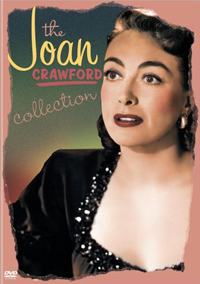
|
The Joan Crawford Collection Warners B&W 1:37 flat full frame Street Date June 14, 2005 49.92 (or separately at 19.97) Reviewed by Glenn Erickson |
Joan Crawford continues to be the prime example of the studio-manufactured movie star. The ambitious and tenacious flapper of the 20s practically absorbed the glamour factory of MGM into her bloodstream, transforming herself from just another Texas hopeful into every shop girl's idea of sophistication. Never a great actress but always a good screen player, Crawford rode on the 1930s wave of image creation through photo sessions and magazine layouts. Always the Queen of Publicity, she created an artificial celebrity, and then inhabited the role for fifty more years.
Crawford's time at MGM was spent in various losing battles for dignity and better roles, as she couldn't compete with actresses like Greta Garbo or Myrna Loy for talent or versatility. It was hard enough keeping youngsters like Loretta Young at bay. She ended up in some fine pictures and practically monopolized the fashion & style end of the fan spectrum, but the boss's wife Norma Shearer always nabbing the great roles, even after the boss passed away.
The Joan Crawford Collection has three new-to-DVD offerings and two repackaged titles. Only one is from MGM, her famous Joan Collins-like bad girl appearance in The Women. Crawford sat out a couple of war years and then came back like a fireball at Warners in Mildred Pierce. Having learned all of the studio angles at MGM, she exercised every ounce of control she could to ensure that the comeback movie would be the start of the 'real' Crawford career. The plan worked beautifully, and Crawford's Best Actress Oscar insured her of special treatment at Warners for several years to come. The only possible rivals she had at that studio were Ida Lupino and Bette Davis, but Davis didn't want the same kinds of roles, as had Norma Shearer. All that slowed Joan's momentum was the fact that she was pushing forty and no longer credible as a 20-something shop girl.
The remaining three titles in the collection are Crawford's immediate follow-ups to Mildred Pierce, vehicles she picked for herself. Within her acting range, they're impressive enough, but they represent a slide into a strange new tough-woman persona. For the rest of her career, Crawford's roles were almost always crazy-mirror reflections of her angry personality: Always under attack, always misunderstood, always being betrayed.
Note: The first two discs in the Collection came out first in 2002, so I've provided links to the original Savant reviews.
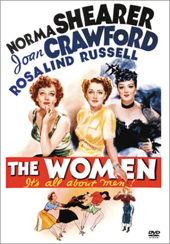
|
The Women can be found at this URL. (note: the photo on the back of this new release of The Women is actually from a movie made 25 years later - 7 Women!) |
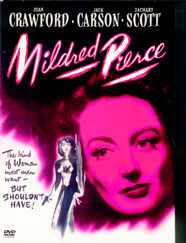
|
Mildred Pierce can be found at this URL. |
|
Humoresque 1946 / 125 min. Starring Joan Crawford, John Garfield, Oscar Levant, J. Carrol Naish, Joan Chandler Cinematography Ernest Haller Art Direction Hugh Reticker Film Editor Rudi Fehr Written by Zachary Gold, Clifford Odets from a novel by Fannie Hurst Produced by Jerry Wald, Jack L. Warner Directed by Jean Negulesco |
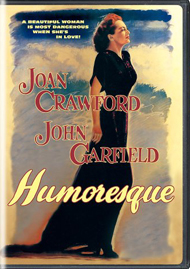
|
Fresh from the success of Mildred Pierce, Crawford chose to double back into her past to create the kind of role she'd often been denied at MGM. 'Poor girl' Crawford recast the MGM fantasy in Warners' conflicting fantasy: The ghetto was a place of decent people who invariably raised musical prodigies, except in gangster films where the offspring were split 50/50 between hoodlums and priests.
The smart set at MGM were witty sophisticates in tuxedoes. In Humoresque, the rich are described by Crawford's dissipated society lady as useless and silly. But the role was a perfect vehicle for Crawford to revel in knockout fashion designs while reeling from one scene to the next in a state of melancholy angst. As in the old MGM movies, anything about swanky music is above reproach and the height of sophistication. Talent is evidence of superior humanity, and to be worshipped. Only the ultra-superior Crawford character has special privileges. Supposedly a musical bio of a violinist dedicated to his work, Humoresque is a classic case of the "It's really about me" syndrome: Crawford's delirious Helen makes the ultimate sacrifice to her lover's music, while really hogging the stage for herself.
Slickly filmed and packed with faux-witty lines (most of them given to sourpuss comedy relief Oscar Levant, the wet blanket of the 1940s), Humoresque traces a barely coherent line of emotions. A man's success story becomes a tragedy for the woman who sponsors him - under that cynical exterior she is cultured and vulnerable, and moved beyond words by the magnificence of his playing ... but simultaneously wants Boray to drop his fiddle whenever she needs him. It's a complex problem that Crawford's acting really doesn't illuminate.
Assuming that Joan Crawford finessed the character (if she did not dictate it from the word Go), Helen Wright is her idea of a real woman's love: Classy and up-scale, but all consuming to the point of delirium. In direct terms, Helen Wright hardly makes sense. She wants it all or nothing, and wouldn't be happy if Paul Boray played his concerts with an "I Love Helen" neon sign around his neck. Nothing's enough ... which might have been Crawford's attitude to life in general.
Crawford hounds will get their fill. The visuals are split between standard glamour work (she still looked splendid in her late 30s) combined with Joan's personally-devised 'dramatic' lighting schemes, the kind that threw deep shadows across parts of her face, highlighting her eyes as if they were staring out of a mask. In the 1930s her standard look was a languid, dreamy expression, but from here on in she'd play at least a third of each film with an exaggerated look of anguish on her face.
Savant doesn't have much respect for Humoresque as a movie - it's pure kitsch that drags in highbrow music for padding and cheaply bought 'class. At least twenty minutes are spent on top-ranked symphonic standards used to buttress the film's flimsy emotional arc. There's a fast-paced montage representing Paul's enormous energy as coming from the streets of the city. The concert scenes are a major laugh. The rapturous Helen starts breathing so heavily that she attracts the attention of everyone who is supposed to be watching the stage. Remember, It's Really About Her.
The actual plot is reduced to functioning as Helen's romantic barometer: she seduces Paul (against her will, she claims), rhapsodizes over him (classical music as a lofty substitute for sex) and then goes nuts. She alternately rages when she can't control her consort, or sinks into depression out of fear that her influence will ruin his talent. Technically adroit and handsomely edited, the big socko finish is gushier than anything from hardcore Garbo weepies or silent films. Nothing less than a big noble sacrifice will do, on a visual plane that elevates Helen (and Joan) to godlike status.
Jean Negulesco directs in the standard Warners house style; we've all heard the stories about a real violinist's hands operating the violin while John Garfield stands with it jammed under his chin, his own arms folded behind his back. Joan Chandler is good in a tiny role as Garfield's wholesome love interest, but Crawford makes sure she hasn't a chance to hold onto audience sympathy. In any other movie, Chandler would be waiting for Garfield at the fade out. In a Crawford vehicle? Fat Chance.
Warners' DVD of Humoresque is a great transfer of a very clean element, although the packaging doesn't tout any special restoration. Franz Waxman's musical arrangements are indeed well recorded. A trailer is included that screams Crawford at top volume, even representing her Oscar from Pierce on-screen.
Creative Domain takes a different tack with The Music of Humoresque, in which musicologists and others (including Waxman's son) assure us that the movie is the height of musical art. I think the movie's artistic aspirations show up in the choice of actors for conductors. Stowkowski lookalike Fritz Leiber plays the 'good' conductor who promotes Paul Boray, while the insensitive hack that fires Paul (for protesting the mutilation of a classical piece) is played by Nestor Paiva, an actor that specialized in lowbrow bad guys and scurvy boat captains.
The disc cover illustration is derived from some beautiful poster art.
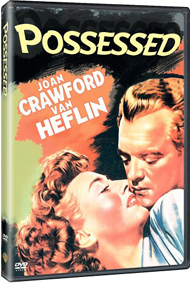
|
Possessed 1947 / 108 min. Starring Joan Crawford, Van Heflin, Raymond Massey, Geraldine Brooks Cinematography Joseph Valentine Art Direction Anton Grot Film Editor Rudi Fehr Original Music Franz Waxman Written by Ranald MacDougall, Lawrence Menkin, Silvia Richards from a story by Rita Weiman Produced by Jerry Wald, Jack L. Warner Directed by Curtis Bernhardt |
Crawford's next A-picture vehicle is another class item produced by Jerry Wald, her Mildred Pierce collaborator. A writer from that movie, Ranald MacDougall, is also back again. Crawford showed considerable career loyalty to some of her co-workers, and it doesn't hurt to mention that she routinely found bit parts for old character actors from as far back as her silent days. Monte Blue and Creighton Hale often appear in tiny parts.
This is Crawford's second go at the title Possessed. The first was one of her poor-girl-hits-the-big-city numbers from the depths of the Depression at MGM. This Possessed is a slick psychoanalysis story, clearly made to get in on the noirish success that other actresses were having in films about mental illness. It's an absurd melodrama that can't make up its mind exactly why its leading lady is a nut case - it seems to come to the conclusion that romantic frustration is a direct cause of schizophrenia.
Joan Crawford succumbs to 'movie psychosis' in Possessed - everything that happens to her seems to be a direct result of emotional pressure brought on by a failed love affair. Although somebody did their homework on the details - Crawford's Louise Howell is seen doing obsessive little things like repeatedly clicking a cigarette lighter - it's still an awkward hoot. Picked up as a loony on the dawn streets of Los Angeles (we get to see a real Red Car!), Louise is taken to the public County Hospital, where she gets the exclusive attention of a doting ace psychosis specialist. He spends what seems to be days on her case alone.
The flashback story that Louise tells might well be a parody of the flashback gimmick, cued by associations (water in a glass = the 'black' water of a search for a drowning victim) but always arranged in neat little acts. Louise 'remembers' plenty of moments when she wasn't even present, like private conversations between David and Dean, or David and Carol. The movie isn't sophisticated enough to imply that the psychotic Louise was listening at keyholes.
This is one of the more popular Crawford titles, which has always amazed me. She seems more stiff and artificial than ever, and it's hard to distinguish when she's supposed to be bonkers and when she's simply trying to act unemotional.
One thing the movie has going for it is great second unit photography, presumably by Robert Burks, who later became Alfred Hitchcock's camera ace in his run of great 50s movies. The movie doesn't have a unifying look but there are several special sequences with subjective camera tricks and other precise visual effects-oriented cinematographic gags that look great. The most famous one is a repeated sequence in which Louise first fantasizes some violent events at the top of a staircase, followed immediately by a 'real' (?) version of what happened. Again, Crawford's acting doesn't help clear up several issues, like how Elizabeth Graham really drowned. We later find out that Louise has turned into a chronic liar and is not responsible for her actions. If that's so, are we to take her flashback memories as the absolute truth?
Although I've never heard it mentioned, film noir fans might agree with me when I perceive Louise Howell Graham's story as practically identical to the 'back story' of Billy Wilder's Double Indemnity. In that movie, Barbara Stanwyck was the nurse of a sick woman who died in her care - in a mountain cabin, if I recall correctly. Stanwyck later married the husband, much to the distress of the woman's daughter. In that movie, it is revealed (or strongly implied) that Stanwyck actually murdered the wife as a first step to get the husband's money.
Crawford's Louise Howell at one point thinks that she's done the same thing, but it turns out to be just one of the various guilt trips she puts on herself. It is a little strange when both she and Dean Graham claim to not have a relationship, but later start one anyway. I'd be suspicious, especially when the amoral David Sutton also admits that he's indeed quite interested in the Graham fortune. An 'alternate read' of Possessed could easily have Crawford's character be just as diabolical as Barbara Stanwyck's, even to the degree of faking insanity to avoid a sticky murder rap.
Little Gerald Perreau plays Massey's young son; he's a dead ringer for his younger sister Janine, the creepy (and possessed) alien zombie girl from 1953's Invaders from Mars.
Warner's DVD of Possessed looks terrific; the older transfers were miserably blotchy and damaged. Here we see only one patch of spotting in just a couple of shots. Warners' audio is strong; they were just getting into a period when their sound engineers designed really punchy, dynamic tracks.
The extra is a featurette called Possessed: A Quintessential Film Noir that uses a number of writers and historians to sketch a much too light picture of the style. Dialogue bites from the participants are short and choppy, and not much is gained. Talents like James Ursini and Dr. Drew Casper could possibly have been more effective on their own.
Casper contributes a rather dramatic commentary for the film that discusses Possessed from all known angles while simultaneously analyzing many shots for their noirish mannerisms. He has a distinctive style clearly developed from years of film school lecture experience.
A trailer is included.
|
The Damned Don't Cry! 1950 / 103 min. Starring Joan Crawford, David Brian, Steve Cochran, Kent Smith, Selena Royle, Jacqueline deWit, Morris Ankrum, Richard Egan Cinematography Ted McCord Art Direction Robert Haas Film Editor Rudi Fehr Original Music Daniele Amfitheatrof Written by Harold Medford, Jerome Weidman from a story by Gertrude Walker Produced by Jerry Wald Directed by Vincent Sherman |
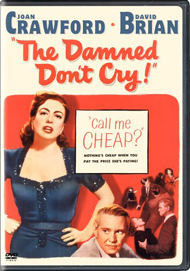
|
As one can probably tell, Savant is on the sour side when it comes to Miss J.C.. I like her really good movies and can sometimes stand watching one of her later Camp-fests when the mood is right. Of the three first-time DVDs in this box, The Damned Don't Cry! is easily the most fun. It's a trashy takeoff on a Warners gangster film, showing the rise and fall of Joan Crawford's moll as a female James Cagney. Crawford, director/lover Vincent Sherman and producer Jerry Wald were 100% serious, yet the show plays as an over-hyped parody of the genre, from the sketchy, too-fast pace to the overbearing music stings. In other words, it's great fun.
The Damned Don't Cry! combines Warner's standard gangster plot with the true story of Virginia Hill and Bugsy Siegel, a scandal then only a few years old. Nick Prenta is associated with a desert gambling Mecca and has problems with the mob, just as was Bugsy Siegel. It's easy to distinguish this downgrade thriller from Crawford's more prestigious earlier Warners work: studio head Jack Warner opts not to give himself a producer credit.
The plot also encapsulates big pieces of Mildred Pierce (especially the first marriage) and Crawford's earlier rags to riches stories like Sadie McKee. Ethel Whitehead has a name that sounds like a pimple but, like Crawford herself, quickly transforms into a worldly woman with just the right application of clothing, makeup and manners. Along the way she undergoes at least one hilarious time-jump across a fade, transforming instantly from a reasonably chaste woman into a gum-chewing tramp who walks into men's offices wearing a slip.
David Brian had already played opposite Crawford in the slightly more serious Flamingo Road, and here his brassy, staccato way of talking creates a proper gangster feel, while mixing well with Crawford's over-sold passion. It's possible to take the whole enterprise seriously, but a lot more fun to see it as an intentional/unintentional parody. Crawford and Kent Smith have a scene in the back seat of a car that telescopes ten years of film noir loser philosophy into a few super-cynical sound bites.
The movie has a lightning-quick pace and an almost cartoonish knack for oversimplifying its main points. The oilfield backdrop for Ethel's awful shack of a home looks like a joke out of a Tex Avery cartoon, as does her drawn and bloodless face. She swaggers around the dress factory like a two-bit Carmen, trading cheap insults with the sour-faced Sandra. The Damned Don't Cry! is one of the first Crawford pictures where we can see her making sure that there is no other female character around who can take one's mind off of La Joan for a microsecond; Jacqueline deWit is a trooper to let herself be used as a no-respect version of Eve Arden. For the first time, Joan's "I'm so gorgeous" posing doesn't work. It's hilarious when this 'more mature' Crawford turns the heads of dress buyers and bookkeepers as if she were Venus on the half-shell ... in a tight sweater.
The distillation of plot and characters is best seen when George Castlemen suddenly transforms into a murderous maniac because his #1 moll might be unfaithful. How this lightweight kept the lid on a nationwide gang of racketeers is unclear - we just have to take it on faith that any relationship with Crawford makes a man go to pieces. The movie's title makes us wish that Kent Smith would look at the bawling Crawford at the conclusion and say, "Crying? Are you crying? There's no crying in gangland!"
The Damned Don't Cry! races through its plot in high gear. It uses yet another flashback wraparound format to establish a corpse in the desert and the search for a Virginia Hill-type mystery woman. The cornball conclusion pays off in a burst of violence that the rest of the movie lacks and brings the doomed characters back to her in-laws' little shack in the oilfield. Dabbs Greer is given the final apologetic line for Ethel Whitehead, saying that she might be forgiven anything to get away from that place. That epitaph is a biographical comment about Joan Crawford as well.
Sharp-eyed viewers may spot Ann Robinson poolside in Palm Springs, and Strother Martin as a handsome springboard diver (!).
Warners' DVD of The Damned Don't Cry! is a clean transfer of elements with much better contrast and detail than I remember - it used to be very washed-out on television. There are a few moments of damage, just a rough splice or two here and there. The serviceable soundtrack is really a selection of atmosphere cues. The classy trailer starts with the tagline, "We want to introduce you to the private lady of a public enemy."
Vincent Sherman's lively commentary shows him to be a very sharp man, even though he's approaching the 100-year mark - we should all be so healthy. Some of his observations are contradicted by what we see - he claims that there was no night-for-night filming over a number of shots that really look like night shoots. Sherman spends far too much time merely describing what's on the screen from his point of view. It isn't until the halfway mark that we get much outside comment on Crawford's time at Warners. He isn't anywhere as enthusiastic in talking about Crawford as he was about Bette Davis on his Mr. Skeffington commentary.
The featurette this time is a little livelier, as the assembled talking heads (who are barely allowed a phrase before the editor cuts what they say) have a great time talking about this entertaining film. It's not a source for anything comprehensive or final on the film, but it's not boring either.
Joan Crawford remains a popular favorite from Hollywood's Golden Age, with a lot of the interest deriving from the negative publicity surrounding her private life. But it is tempting to analyze her personality through her movies because the parallels are so strong, especially in later pictures where her 'unworthy daughter' theme kicked in. Still, she gave us the amazing Johnny Guitar and her part of What Ever Happened to Baby Jane? This grouping of her best Warners' work (and an MGM holdover) isn't as substantial as the Bette Davis Collection, but Crawford fans should be very happy with it.
On a scale of Excellent, Good, Fair, and Poor,
The Damned Don't Cry rates:
Movies: TW: Very Good, MP: Excellent, H: Good, P: Good, TDDC: Very Good
Video: All Excellent or Very Good
Sound: All Excellent
Supplements: featurette, trailer, Vincent Sherman commentary
Packaging: Keep case
Reviewed: June 9, 2005
Review Staff | About DVD Talk | Newsletter Subscribe | Join DVD Talk Forum
Copyright © DVDTalk.com All rights reserved | Privacy Policy | Terms of Use
|
| Release List | Reviews | Price Search | Shop | SUBSCRIBE | Forum | DVD Giveaways | Blu-Ray/ HD DVD | Advertise |





